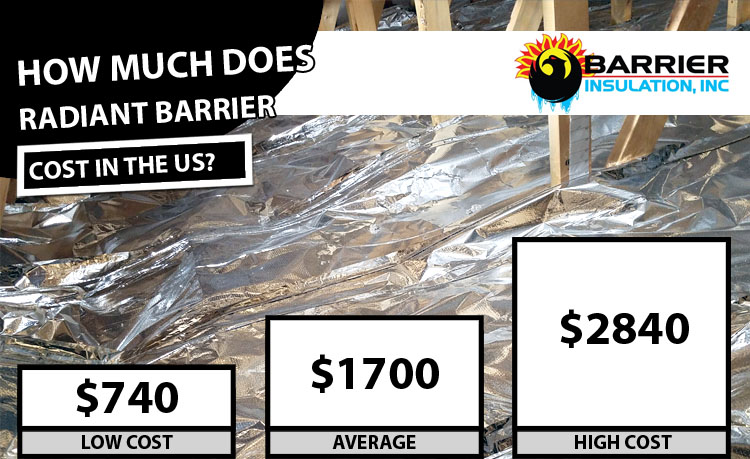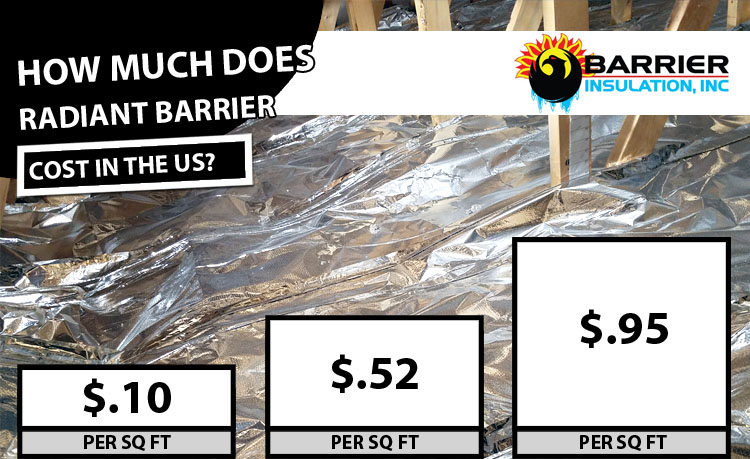Radiant barrier costs about $1,700 with average prices ranging from $740 to $2,840 in the US for 2020 according to HomeAdvisor. Radiant barrier cost per square foot is about $.52 per sq ft with average prices ranging from $.10 to $.95 per sq ft.
Radiant barrier installation for a 1,500 sq. ft. attic costs about $1,700 with average prices ranging from $740 to $2,840.
Radiant Barrier Costs Per Square Foot
Radiant barrier cost per square foot is about $.52 per sq ft with average prices ranging from $.10 to $.95 per sq ft.
According to AngiesList, “In general, you can expect to pay between 10 and 25 cents for every square foot of material you purchase, for single-side barriers. Double-sided barriers can cost as much as 50 cents per square foot. In real numbers, a 1,500 square foot attic space can cost between $225 and $750.”
Single Sided Vs Double Sided Radiant Barrier Cost
Single Sided Randian Barrier. The average cost of single-sided radiant barrier is 15 cents per sq. ft. with average prices ranging from $.10 cents to $.25 per sq. ft. for the US in 2020. Single sided randiant barrier installation for a 1,500 sq. ft. attic costs about $1,700 with average prices ranging from $740 to $2,840.
Double Sided Randian Barrier. The average cost of double-sided radiant barrier is 33 cents per sq. ft. with average costs ranging from $.15 to $.50 per sq. ft. for the US in 2020. Double sided randiant barrier installation for a 1,500 sq. ft. attic costs about $1,700 with average prices ranging from $740 to $2,840.
Installation costs for radiant barrier average 55 cents per sq. ft. Installation costs for radiant barrier ranged from 10 cents to $1 per sq. ft per the Florida Solar Energy Center. The average installation costs to install single-sided radiant barrier as a basic project in a 1500 sq. ft. attic is $400. Prices ranged from $300 to $500. The average installation costs to install double-sided radiant barrier as a complex project in a 1500 sq. ft. attic is $1,300. Prices ranged from $600 to $2,000. generally speaking, costs of installation is usually cheaper for floor applications – the labor-intense process of attaching the radiant barrier to attic rafters is more costly.
Incidentally, if you are involved in the construction of a new home, the costs of installation are usually cheaper. A homeowner in Virginia paid an additional $500 and made his home significantly cooler by installing 5,000 sq. ft. of radiant barrier foil over the rafters before the roof was covered.
How Much Energy Does A Radiant Barrier Save?
A radiant barrier can reduce cooling costs by 5-10 percent in a warm and sunny climate according to the US Department of energy who also mention that radiant barriers are more effective in not climates than in cold climates.
According to AlternativeEnergy, “PRO Attic Radiant barrier costs $300 to $1,200 and can save you $9,000 over the next 25 years.”
HomeAdvisor says, “If homeowners upgrade to R19 insulation, they can save from $180 to $300 on heating bills.”
Radiant Barrier Tax Credit
You can get a tax credit for 10 percent of the cost up to $500! This does not include the cost of installation but it is possible to perform the installation of home sealing/insulation yourself and receive the credit per Consumer Reports.
Factors That Affect The Cost.
There are a few factors that affect the cost of installing radiant barrier insulation in your Phoenix valley home. One of the biggest factors is the size of the home. The bigger the attic and the greater the square footage, the more time and materials it will take to get the job done.
Another cost factor is which radiant barrier solution you choose. If you want to pay the difference between a spray on heat barrier or if foil insulation would work in your application affects the cost. Discuss the options with your Phoenix insulation company to get more information on which radiant barrier option works best for your home, and your budget.
Why Install Radiant Barriers?
Summer heat is one of the biggest primary concerns when discussing insulation in Arizona. Winters do cool off and near-freezing nights happen, so insulation is relevant all year long. Radiant barriers work alone or in conjunction with other insulation types to keep our attics cool. Keeping the attic cool helps reduce the heat transferred through the attic floor and into our homes. Radiant barriers help reflect heat energy before it has a chance to even make it through the roof. This means that the spray foam, rolled batt, or other insulation types don’t work as hard to keep your energy bills lower.
Types Of Radiant Barriers
There are two main categories of radiant barrier insulation, paint like coatings and radiant foil. There are different companies making paint-like coatings that act as your radiant barrier that is applied via either a spray type paint process or are applied via a brush and roller. Foil can be installed against rafters leaving a gap of air, or they can be simply laid over your traditional insulation on the floor of your attic. If the attic is used for storage choosing a system that is applied to the underside of the roof is the best call to leave your attic space free and clear.
Advantages Of Radiant Barrier Insulation
Radiant barrier insulation has the advantages of keeping homes cooler and saving energy but has some unique advantages of its own. Apart from the advantage of simply rejecting heat from entering the home at the rooftop, it has the following advantages:
- It takes up less room than standard insulation types
- Dried paint radiant barriers and foil are noncarcinogenic and non-toxic
- Neither paint type nor foil supports the growth of fungi or bacteria
- These insulators will not mold or mildew is there is a leak in your roof
- They do not degrade due to the presence of moisture
- They do not age and degrade with time or lose thermal efficiency
Radiant Barrier Installation in Phoenix
If you have a home that could use better insulation and lower energy bills installing radiant barrier insulation by Barrier Insulation, Inc in your Phoenix home can greatly help reduce your energy costs leaving you more money for all of the other needs and wants you have in your life.


